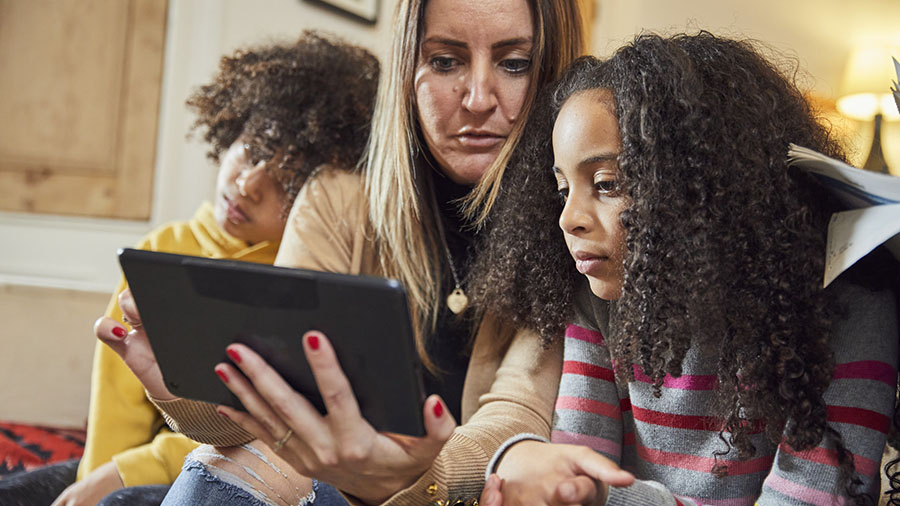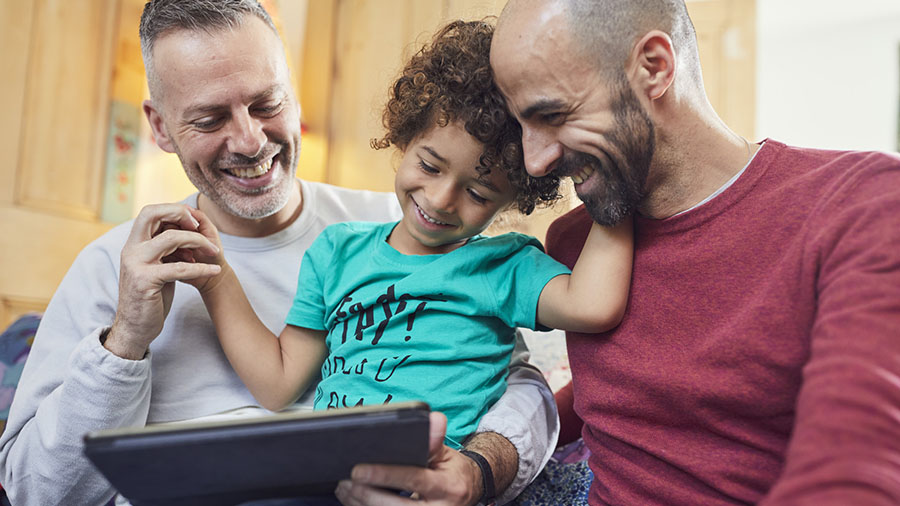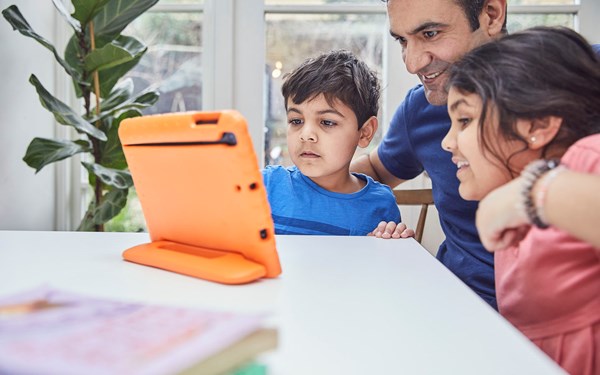Starting the conversation

Talking regularly with your child can help keep them safe online. Making it part of daily conversation, like you would about their day at school, will help your child feel relaxed.
It also means when they do have any worries, they’re more likely to come and speak to you.
But it’s easy to become overwhelmed with the different technology, the language that children use, the huge number of games and apps which are available and the potential risks.
Age-appropriate conversations
For under-11s
- Resources like Talk PANTS and Techosaurus will help.
- Make sure you’re using language they can understand.
- If you suspect grooming or exploitation, you can report this directly to CEOP.
For older children and teenagers
Their needs and behaviour will be changing and they may find talking to you about difficult topics embarrassing.
Online safety family resources
English
Online safety top tips (PDF, 96KB)
Family agreement:
Interactive PDF (185KB)
Printable PDF (156KB)
Online safety word search (PDF, 152KB)
Online safety quiz:
Interactive PDF (217KB)
Printable PDF (184KB)
Family games night activity (PDF, 567KB)
Cymraeg
Diogelwch ar-lein: syniadau da (PDF, 97KB)
Cytundeb diogelwch ar-lein i'r teulu (PDF, 151KB)
Cwis diogelwch ar-lein (PDF, 151KB)
Cynnal noson gemau ar-lein (PDF, 589KB)
LEGO® Build & Talk
A core part of the NSPCC’s 10-year strategy is to ensure children are safe online. To help achieve this we’ve teamed up with the LEGO Group to help promote their fun, free Build & Talk activities. The six 'adventures' help parents and caregivers talk with their children about key online safety topics through the joy of LEGO play.
Need advice about online safety?
If you’re stuck, not sure what to do, or if you’re worried about your child, you can also contact our trained helpline counsellors on 0808 800 5000.
Childline also has lots of information about online and mobile safety that will help you and your child.
What are the risks for children online?
There are potential risks for children online. Consider these things when you talk with your child about what they're doing online:
When they’re playing a game, using an app, watching YouTube channels, what sort of content is there? Have they seen any inappropriate content and if so, what did they do? How did it make them feel?
Most games and social media apps have various communications features, from text chat to voice chat, messaging and private messaging, video and image sharing, livestreaming and more.
Ask about the friends they play with. What is the difference between online and offline friends? Do they talk to people they don’t know online? If so, why and what are they sharing?
There can be lots of different reasons why children talk to people they don’t know online, such as same interests, talking gaming tactics and even for support and advice.
When they play those games or use those apps, what is their behaviour? Do they feel anxious? Do they sometimes get angry for example when they play fast-paced games and lose?
Tackling difficult conversations
Some conversations are going to be more difficult than others. But it's so important to have them, so you can support your child with their worries or issues.
You might be worried they have been viewing online pornography. Or perhaps you're concerned they've been sharing nudes. Maybe they have seen upsetting, inappropriate or explicit content, or perhaps they're being bullied. These more difficult conversations will heighten feelings of fear, anxiety, worry, shame and embarrassment.

As with any conversation, it helps to stay:
- calm
- balanced
- non-judgemental.
If it's something that has made you angry, fearful or concerned, don’t tackle it while you're feeling highly emotional.
Take a little time and, if possible, talk to someone else about it. Your child’s school can be a great source of information, particularly the class teacher and the Designated Safeguarding Lead. You can always contact us for advice.
Don’t be too forceful, otherwise there is the risk that they will close down.
Consider a subtle approach instead of a head-on approach. For example, you could ask if the subject is discussed at school and what they learn about it, or it could be something that has been on the TV or you heard about it on the radio.
Keep listening, try not to interrupt even if there is a period of silence. They may be thinking how they word something.
Provide context. Allow them to understand why some things are wrong, age inappropriate or even illegal. In order to critically think and assess, they need information.
Remind them of your family values. Some parents may think that something is okay for their children. You could explain why you don’t think it is appropriate for them.
Children often talk of being punished. For example, if they open up to you and say that they have seen explicit content by accident, they are scared of their devices being removed from them. This is seen as a punishment and consequence for something that was out of their control. This is a judgement call that needs to be carefully handled.
How could my child feel talking about online safety?
It can help to think about how your child could feel sharing what they’re doing online before you talk to them. There could be a range of different emotions, such as:
- Discomfort or embarrassment about something they have said online.
- Shame or fear if they're worried about something they have seen or done.
- Annoyance or confusion if they don’t understand something.
- Happiness because they have received validation for what they’ve posted – such as likes or follows.
- Try to remain calm and balanced, even if you're feeling angry or shocked.
- Be positive but also open about anything you’re worried about. You could say “I think this site’s really good,” or “I’m a little worried about things I’ve heard about this app.”
- Ask if they’re worried about anything and let them know they can come to you or another adult they trust.
- Listen for the reasons why your child wants to use apps or sites you don’t think are suitable, so you can talk about these together.
- Ask your child what they think’s okay for children of different ages, so they feel involved in the decision making.
Next steps to take
Having a conversation with your child can give you a good insight into their online activities so that you can consider:
- Are further options, such as parental controls, required?
- Are the games and apps they’re using appropriate to their age?
If you can, agree some rules with your child about what games and apps they’re allowed to use. While there are risks with most online platforms, we'd recommend only letting your child use apps that have privacy settings and a 'report and block' feature.
Do they know about the safety and privacy features of the apps they're using? Such as:
- Privacy settings. Are their accounts public or private?
- Do they know how to block and report? Are those features available?
- Can you turn features off, such as chat and in-app purchases?
- Do they know what personal and private information is, and what is and is not appropriate to share online?
- What are their profiles on their games and apps? What does the profile say about them? What does the image or avatar say about them?
Being a good digital role model

Children get lots of messages about online safety in school and at home. They can feel confused if the adults around them don't seem to be following the advice they’re giving.
Your children look to you for guidance and there are lots of things you can do to set a good example.
Make sure you aren't sharing passwords or writing them down where others can find them. Talk with your child to remind them that passwords are private and shouldn't be shared.
It can be good for all of us to have a break, so set an example and use device settings to turn off notifications sometimes.
There has been a huge rise in fake and false information shared online. So it's helpful to talk to your children about what you have seen (if it’s appropriate to do so) and why you have questioned it. This helps them to develop critical thinking skills.
We tell children to be careful about the pictures they share online, such as in their school uniforms. But at the start of every school year, many parents do this. It can be confusing for your child, but also an opportunity to discuss how you are doing this safely, such as by sharing but using privacy settings.
Modelling good behaviour includes asking for your children's permission first and not over-sharing. You could show them the image you want to share, assure them you are only sharing with family and that you have privacy settings in place. If they say they don’t want that image shared, then it's best to respect their feelings.
Other people children can talk to
But no matter how hard we try, there may be things that children won’t open up to, so it’s important that we give them other options. That could be:
- another adult family member, e.g. aunt, older cousin etc.
- a teacher or member of the pastoral team in school
- Childline on 0800 1111 or visiting the Childline website.






